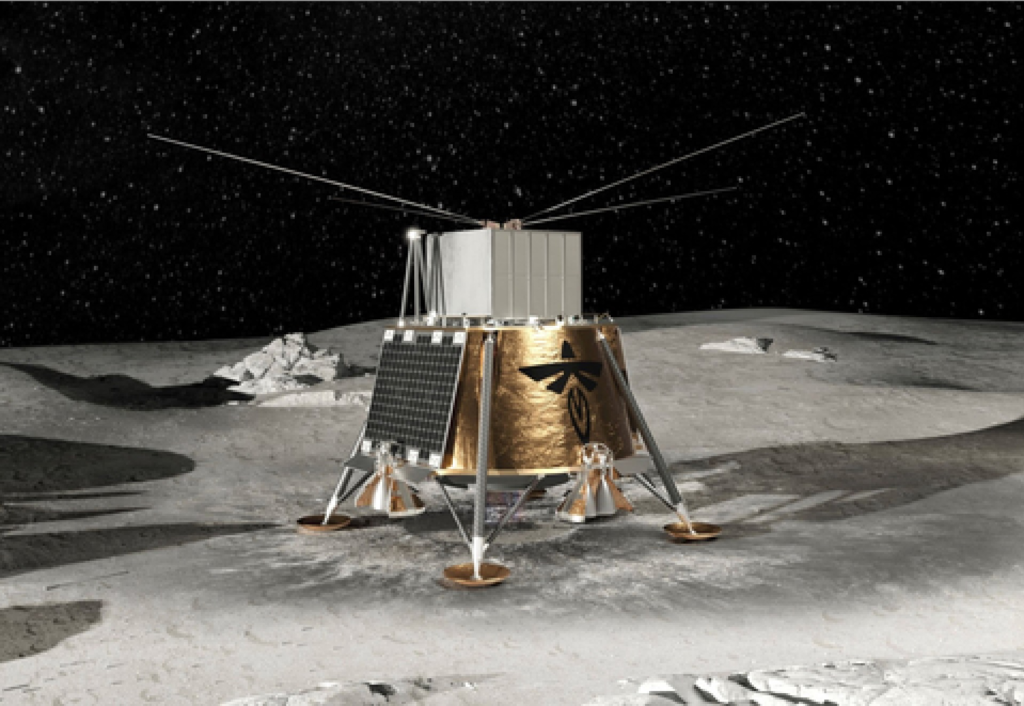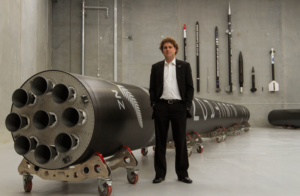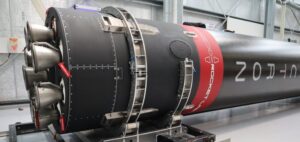
The Small Rocket Company Trying To Land On The Moon
In recent years, global interest in the Moon has spiked with different agencies around the globe launching dedicated lunar missions. The jump in missions has also meant quite a few more failures have occurred with the Moon being extremely difficult to land on. Despite this, a relatively small company has been working on a lunar lander that is almost ready to launch for the first time.
Firefly Aerospace was founded less than a decade ago in 2014. In the time since then, they have launched their small lift launch vehicle twice, with varying results. In addition to working on a launch vehicle, they have been developing a unique lunar lander meant to not only land on the Moon but support the various payloads it brings with it.
Named Blue Ghost, this lander stands 2m (6.6ft) tall and 3.5m (11.5ft) wide, weighing 2,700kg with the transfer vehicle. With its first launch and landing attempt possibly only months away, all hands are on deck preparing this vehicle and its payloads. Here I will go more in-depth into the first upcoming mission, the lander design, its busy future, and more.
Upcoming Mission

All the way back in early 2021, NASA awarded Firefly $93.3 million to deliver a suite of ten NASA-sponsored science and technology demonstration payloads to Mare Crisium in the Moon’s Crisium basin, a large basin located in the northeast quadrant of the Moon’s near side. This specific location has been the subject of previous lunar missions including the Soviet landers Luna 15, Luna 23, and Luna 24. In 2012, the NASA GRAIL mission confirmed and mapped a mass-concentration at the center of the basin. Mare Crisium was created by early volcanic eruptions and flooded with basaltic lava more than 3 billion years ago. This first lunar surface mission will explore this region’s regolith properties, geophysical characteristics, and the interaction between solar wind and Earth’s magnetic field. These investigations are meant to help prepare for human missions to the lunar surface.
Specifically, apart of this contract, the lander will operate on-board payloads through lunar transit, during lunar orbit, and on the lunar surface for a complete lunar day (about 14 Earth days) and well into the freezing dark of lunar night. In addition to the NASA-sponsored payloads, the lander will carry more than 50 kg of commercial payloads.
Interestingly, in terms of launching and delivering the lander to the Moon, Firefly doesn’t have a vehicle with the capability. While the company is working on a medium lift launch vehicle that could in theory take Blue Ghost, it won’t be ready for years, and Firefly needs to launch soon. For this reason, the company awarded a contract to SpaceX to launch the lander for them. At the time, Firefly’s senior vice president said, “Firefly is excited to fly our Blue Ghost spacecraft on the highly reliable Falcon 9. The high performance of SpaceX’s Falcon 9 launch vehicle permits a lunar transit using minimal Blue Ghost propulsion resources, thereby allowing the lander to deliver more than 150 kg of payload to the lunar surface” he said.
Currently, the mission is set to happen next year and land on the surface of the Moon around mid-2024. The original plan was 2023 however this was pushed back due to delays and various reasons. As far as progress goes, a few days ago on the 11th the company tweeted saying, “Our Blue Ghost lunar lander panels are lookin’ good for our first mission to the Moon! Propulsion lines are nearly fully installed as we get ready to stack the in-house manufactured panels.” This included an image of the lander which is nearing completion. Last month the harnesses were qualified and installed on Blue Ghost.
In addition, 8 of the 10 payloads have been delivered to the company and prepped for integration into the lunar lander. Each of the 10 payloads are from different entities including universities, NASA, space companies, etc. For a while now, Firefly has been developing, qualifying, and manufacturing Blue Ghost at its spacecraft integration facilities in Cedar Park, TX, about 30 minutes north of Austin. Lander Program Manager Shea Ferring stated, “We are utilizing our Austin-based AS9100-certified engineering, test, and production facilities to build and operate world-class spacecraft. NASA’s support for our lunar program allows us to increase our capabilities for in-space services to the benefit of both U.S. government and commercial customers” he said. As it turns out, Firefly wants to land on the Moon much more than just a single time.
The Blue Ghost Plan

To put in perspective the future launch cadence of this hardware, Firefly is already working on a second lunar mission. In addition to the contract for the landing next year, they were also awarded a $112 million NASA contract to deliver multiple lunar payloads in 2026. This second contract from NASA shows the agency’s confidence in the design, plan, and general development of this hardware.
As Firefly’s second task order won under NASA’s Commercial Lunar Payload Services (CLPS) initiative, the company will use its Blue Ghost spacecraft in a two-stage configuration to first place a satellite into lunar orbit and then deliver two research payloads on the far side of the Moon. In other words, before landing on the Moon, the company’s Blue Ghost transfer vehicle will deploy the European Space Agency’s Lunar Pathfinder satellite into lunar orbit to provide communications for future spacecraft, robots, and human explorers. After touching down on the far side of the Moon, the Blue Ghost lunar lander will then deliver and operate NASA’s S-Band User Terminal, ensuring uninterrupted communications for lunar exploration, and a research-focused payload that measures radio emissions to provide insight into the origins of the universe. This uniquely “quiet” landing region is shielded from Earth-born radio frequency noise. The Moon further shields noise from the Sun during the lunar night, making the region perfectly suited to collect valuable data on the cosmic Dark Ages.
One of the reasons this lander was picked for multiple missions has to do with its unique design. For example, they highlight that almost any landing site on the near side of the Moon is achievable with Blue Ghost, including the lunar poles. Their baseline lunar capture orbit is near-polar, providing access to any surface location. Communication back to the Mission Control Center (MCC) presently requires line of site to Earth, limiting transmission from polar regions to times when the Moon’s orbit about the Earth brings the relevant pole into view. However, the lander is designed to survive through communications blackout periods and to operate autonomously so long as the sun is shining. On-board processing and storage are used to operate payloads and store data gathered during blackouts so that they can be transmitted when communications become available again (usually after 8–20 days).
Blue Ghost is designed to operate for as long as it is illuminated, up to 14 days in most locations. There are two baseline lander configurations to accommodate power and thermal solutions at different latitudes. Mid and equatorial latitudes use three fixed solar arrays. For polar missions, the lander has less radiation area and accommodates longer operating periods at sites where extended periods of illumination are available. Extended operation at the poles is achieved through use of a deployable panel with a single-axis gimbal to track the Sun at any solar azimuth. These different options open up more opportunities for the lander and Firefly Aerospace.
It also has somewhat of an upgraded variant depending on the mission. On the second NASA contract we should see this hardware in use. Firefly’s third-stage vehicle will serve as a transfer vehicle for Blue Ghost on Mission 2. The vehicle can deliver 2,700 kg of payload capacity to lunar orbit with the ability to provide on-orbit services for up to 5 years. It also has sufficient propellant reserve to enable a variety of advanced mission opportunities, such as lunar sample return to Earth and further exploration to nearby planets like Mars and Venus.
Two years ago, Firefly reached a major milestone with the successful completion of the Critical Design Review (CDR) of their Blue Ghost lunar lander. The CDR paved the way for construction of the Blue Ghost Lander. Next in early 2022, they completed the Integration Readiness Review (IRR). During the review, the team marked key progress milestones across multiple areas, including: Structures, Fluids, Propulsion, Core Avionics, Battery Production, Harness Production, and much more. The completion of IRR came less than six months after completing the Critical Design Review (CDR). “The short turnaround between our CDR in October and IRR is a testament to the soundness of the baseline lander design, forward planning by program, and the creativity of our engineers in overcoming supply chain and other challenges as they arise,” said Will Coogan, Blue Ghost Chief Engineer.
The next step was completing the Lander Test Readiness Review which verifies readiness for primary system functional testing. In the next few months, we can expect even more updates on the system and the delivery of the two final payloads.
Conclusion
Firefly Aerospace is a relatively small rocket company that is about to try and land on the Moon. At first, using SpaceX’s Falcon 9 as a launch vehicle, they will attempt to land and support 10 different payloads on the surface for at least two weeks. We will have to wait and see how it progresses and the impact it has on the space industry.



